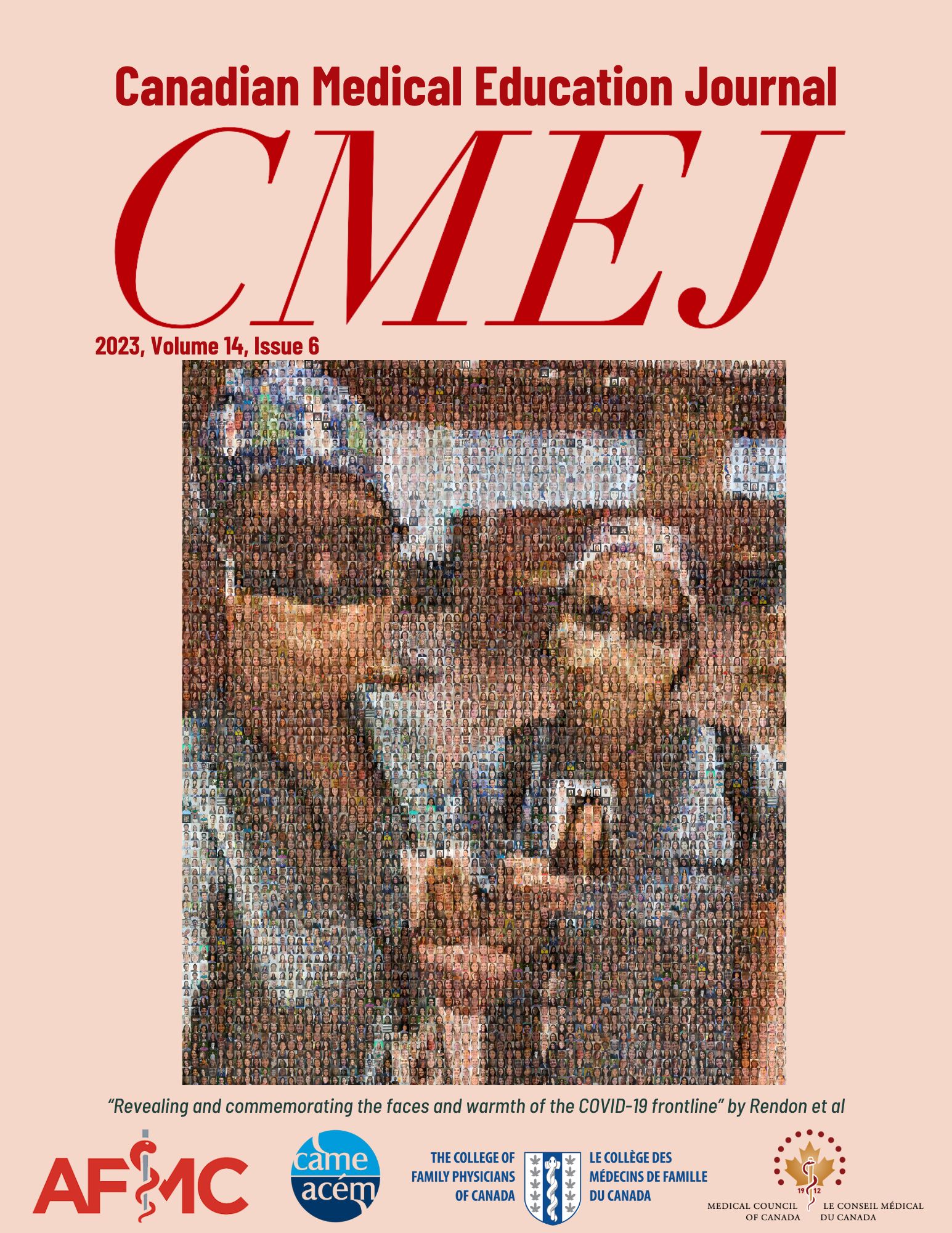Perspectives of Indigenous medical students on a postgraduate Indigenous admissions pathway
DOI:
https://doi.org/10.36834/cmej.75170Abstract
Objective: The objective of this study is to assess the perceptions of Indigenous medical students on postgraduate admissions through an Indigenous admissions pathway (IAP), and to determine what factors may influence Indigenous medical students’ choice of residency training program.
Methods: We distributed a survey to self-identified Indigenous students at settler Canadian medical schools. The survey questioned the students’ acceptability of an IAP, and what factors would influence application through an IAP. Analysis included descriptive statistics and thematic analysis of open-ended questions.
Results: Thirty-six participants responded to the survey. Location and proximity to family or support system were the most important factors in choosing a residency program. Participants identified mentorship from Indigenous physicians and community involvement as being important features of a residency program that has an IAP. Eighty-one percent of participants felt the availability of an IAP would influence their choice of residency program. Fear of judgement or stigma, concern about entrance requirements, and program logistics were identified as barriers to applying to residency through an IAP. All participants believed that an IAP would have a positive influence on the healthcare system more broadly.
Conclusions: An IAP appears to be an acceptable residency application format to Indigenous students but cannot exist in isolation. It is important for programs to consider the needs and safety of Indigenous trainees within residency programs.
References
Health Council Canada. The Health Status of Canada’s First Nations, Métis and Inuit Peoples Toronto, ON; 2005. Available from: https://healthcouncilcanada.ca/files/2.03-BkgrdHealthyCdnsENG.pdf [Accessed on Sep 6, 2020].
Allan B, Smylie J. First Peoples, second class treatment: the role of racism in the health and well-being of Indigenous peoples in Canada Toronto, ON; 2015 Available from: https://www.wellesleyinstitute.com/wp-content/uploads/2015/02/Summary-First-Peoples-Second-Class-Treatment-Final.pdf. [Accessed on Nov 11, 2021].
Greenwood M, de Leeuw S, Lindsay N. Challenges in health equity for Indigenous peoples in Canada. Lancet. 2018;391(10131):1645–8. https://doi.org/10.1016/S0140-6736(18)30177-6
Curtis E, Wikaire E, Stokes K, Reid P. Addressing indigenous health workforce inequities: a literature review exploring “best” practice for recruitment into tertiary health programmes. Int J Equity Health. 2012;11(1):13. https://doi.org/10.1186/1475-9276-11-13
Sadler K, Johnson M, Brunette C, et al. Indigenous Student matriculation into medical school: policy and progress. Intern Indigenous Pol J. 2017 Jan 16;8(1). https://doi.org/10.18584/iipj.2017.8.1.5
Erasmus G, Dussault R. Report of the royal commission on Aboriginal peoples. Ottawa, ON; 1996 Available from: http://hdl.handle.net/1974/6874 [Accessed on Sep 6, 2020].
Truth and Reconciliation Commission of Canada. Truth and Reconciliation Commission of Canada: Calls to Action. Winnipeg MB; 2015. Available from: http://www.trc.ca/assets/pdf/Calls_to_Action_English2.pdf. [Accessed on Sep 6, 2020].
National Inquiry into Missing and Murdered Indigenous Women and Girls. Reclaiming power and place: the final report of the National Inquiry into Missing and Murdered Indigenous Women and Girls Available from: https://www.mmiwg-ffada.ca/final-report/. [Accessed on Nov 11, 2021].
Fitzgerald C, Hurst S. Implicit bias in healthcare professionals: a systematic review. BMC Med Ethics. 2017 Mar 1;18(1). https://doi.org/10.1186/s12910-017-0179-8
Young ME, Razack S, Hanson MD, et al. Calling for a broader conceptualization of diversity: Surface and deep diversity in four Canadian medical schools. Acad Med. 2012;87(11):1501–10. https://doi.org/10.1097/ACM.0b013e31826daf74
Anderson M, Crowshoe L, Linda M, et al. Joint commitment to action on Indigenous health as approved by the AFMC Board of Directors prepared by writing working group on behalf of the Indigenous Health Network. 2019.
Anderson M, Lavallee B. The development of the First Nations, Inuit and Métis medical workforce. Med J Aust 2007 May 21;186(10):539–40. https://doi.org/10.5694/j.1326-5377.2007.tb01033.x
Swidrovich J. Decolonizing and Indigenizing pharmacy education in Canada. Curr Pharm Teach Learn. 2020;12(2):237–43. https://doi.org/10.1016/j.cptl.2019.11.018
University of Alberta Centre for Teaching and Learning. Indigenizing and Decolonizing Teaching and Learning Available from: https://www.ualberta.ca/centre-for-teaching-and-learning/teaching-support/indigenization/index.html. [Accessed on Apr 23, 2021].
Hlatshwako TG, Shah SJ, Kosana P, et al. Online health survey research during COVID-19. Lancet Digit Health. 2021;3(2):e76-7. https://doi.org/10.1016/S2589-7500(21)00002-9
de Leeuw S, Hunt S. Unsettling decolonizing geographies. Geography Compass. 2018; 12:e12376. https://doi.org/10.1111/gec3.12376
Braun V, Clarke V. Using thematic analysis in psychology. Qual Res Psychol. 2006;3(2):77–101. https://doi.org/10.1191/1478088706qp063oa
Thomas DR. A general inductive approach for analyzing qualitative evaluation data. Amer J Eval. 2006;27(2):237-246. https://doi.org/10.1177/1098214005283748
Cloudflare. What is a Bot? 2020 Available from: https://www.cloudflare.com/learning/bots/what-is-a-bot/ [Accessed on Sep 1, 2020].
Perkel JM. Mischief-making bots attacked my scientific survey Nature. 2020 Available from: https://www.nature.com/articles/d41586-020-00768-0 [Accessed on Sep 1, 2020].
The Association of Faculties of Medicine of Canada. Canadian medical education statistics 2020 Ottawa, ON; 2020. 275 p. Available from: https://www.afmc.ca/wp-content/uploads/2022/10/CMES2020-Complete_EN.pdf [Accessed on Jan 10, 2023].
Scott I, Gowans M, Wright B, Brenneis F. Stability of medical student career interest: a prospective study. Acad Med. 2012;87(9):1260–7. https://doi.org/10.1097/ACM.0b013e31826291fa
Anderson Decoteau M, Woods A, Lavallee B. Unsafe learning environments: Indigenous medical students’ experiences of racism. Lime Good Practice Case Studies. 2017;4:18–25.
Jones C. Levels of racism: a theoretic framework and a gardener’s tale. Am J Public Heath. 2000;90(8):1212–5. https://doi.org/10.2105/AJPH.90.8.1212
Downloads
Published
Issue
Section
License
Copyright (c) 2023 Kristin A Black, Brittany Schroeder, Cassandra Felske-Durksen, Rebecca Rich

This work is licensed under a Creative Commons Attribution-NonCommercial-NoDerivatives 4.0 International License.
Submission of an original manuscript to the Canadian Medical Education Journal will be taken to mean that it represents original work not previously published, that it is not being considered elsewhere for publication. If accepted for publication, it will be published online and it will not be published elsewhere in the same form, for commercial purposes, in any language, without the consent of the publisher.
Authors who publish in the Canadian Medical Education Journal agree to release their articles under the Creative Commons Attribution-Noncommercial-No Derivative Works 4.0 Canada Licence. This licence allows anyone to copy and distribute the article for non-commercial purposes provided that appropriate attribution is given. For details of the rights an author grants users of their work, please see the licence summary and the full licence.






